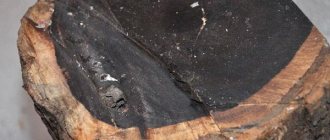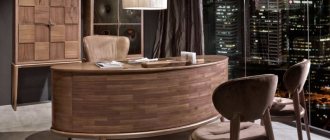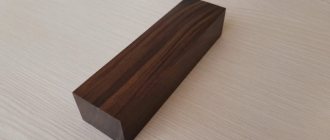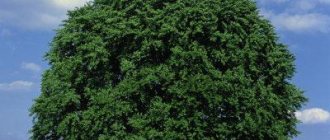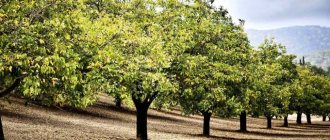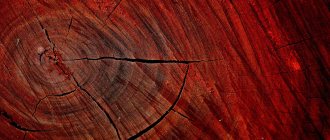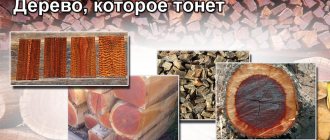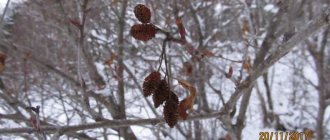The ebony family (ebenaceae) includes several genera of trees, which include the famous ebony. In the trade environment, the name “ebony” unites more than one hundred species, often including various types of dark rosewood, legumes or acacia. Ebony wood can have not only black, but also greenish, red or almost white color.
True ebony includes varieties of the persimmon genus (diospyros), common in the tropical latitudes of Southeast Asia, India, Sri Lanka, Madagascar, Ceylon, West and East Africa. The wood of these species is considered precious and is the most expensive in the world. Certain types of persimmon, related to ebony, are found in the Caucasus. The mountain persimmon breed can be used as a bonsai - the seedlings take root in large pots and grow indoors.
In ancient times, ebony was endowed with mystical powers, attributed the ability to relieve the influence of dark forces, cast spells, rejuvenate, and cure serious illnesses. Items made from it were used in magical rituals and were considered magical. Charms and talismans were carved from wood. In Ancient Egypt, ebony was valued along with gold, precious stones and ivory. Ebony figurines were discovered in the tombs of the pharaohs.
The population of the regions where ebony trees grow used the branches and bark of the trees to prepare healing remedies and magical drinks that gave gigantic powers. The fruits of many species of diospyros are edible, including the familiar persimmon.
Interesting Facts
Undoubtedly, everyone knows the famous horror story about the ebony tree in the black forest. Indeed, over time, many mystical stories and legends have appeared around ebony. Figurines made from this wood could be used in two ways: to protect oneself and one’s home, and for rituals of black magic. This tree could give health and kill, energy is extracted from its raw materials, and the image of the tree is the national symbol of Tanzania. So what else does ebony hide?
Among all the properties of ebony, of which it has a large number, there are also qualities that are sometimes mutually exclusive. It can also go by different names - mukelete, mpingo, zebra wood (ZebraWood), music tree (TreeofMusic), mugembe, ebony tree. Among these names there are those that indicate the nature of the material, denoting its rather fantastic properties.
Ebony tree, mystically attractive, has long attracted people, so a large number of legends and beliefs have always been born around it. According to Pausanias, a scientist from Ancient Greece, the ebony tree is not fruitful, has no leaves, is not remarkable in appearance, but has large roots, which are used by the Ethiopians.
Medicine
Now you can find data that says that the roots of this tree are still used in medicine. A decoction of them is taken as an anesthetic for patients with hernia and abdominal pain. The bark is commonly used for diarrhea, and the smoke is inhaled by burning the roots of the ebony tree to relieve headaches and treat bronchitis.
Even during the reign of the pharaohs, ebony was widespread in Ancient Egypt. So, in the tomb of Tutankhamun, figurines carved from him were found. Also found were Egyptian tablets (analogous to a customs declaration) allowing the transport of ebony from East Africa, and a shipment of wood on a galley that sank in the East Mediterranean Sea.
Legends
Due to the fact that the density of the tree is quite high (approximately 1200-1300 kg/m3) and it is very hard, ebony easily sinks in water. These properties made the material truly magical. By the way, figurines and small objects made of wood served as talismans and amulets, and their owners believed in enhancing properties, and also considered them a symbol of courage and courage.
According to the legends of the ancients, ebony contains powerful energy, the control of which required great skill. The ability to give off a significant amount of heat has also found its application in everyday life. For example, when burning wood raw materials, the thermal energy was so high that the dishes simply could not stand it and began to melt. And the tribes of Africa made charcoal from ebony. Not only were people aware of the properties of ebony as an energy source, but also animals understood that to obtain greater strength they needed to eat leaves and twigs.
Fruit
It must be said that since ancient times, ebony has been surrounded by mystical legends and beliefs. For example, the ancient Greek scientist Pausanias wrote that it is unfruitful and does not even have leaves, but consists only of roots, which the Ethiopians use for healing.
Most ebony trees growing in the tropics and subtropics are evergreen, but there are also deciduous species common in temperate climates. Caucasian persimmon also belongs to this genus. The fruit of the ebony tree is very large and tasty, resembling a tomato in appearance. In ancient Chinese scrolls they wrote about it 3 thousand years ago. Persimmons can be eaten raw, and can also be used to make jam, marshmallows, candied fruits, and even wines and liqueurs. In addition, it is considered a good dietary product.
Definition and properties
Ebony , or Eben - black (or black with stripes) wood of some tropical trees of the genus Persimmon (Diospyros), growing in the tropical rainforests of Western, Central and Eastern Africa, South and Southeast Asia, on the islands of the Indian Ocean, in monsoon forests India and the island of Ceylon.
Heartwood without distinguishable annual rings is very hard and heavy and is one of the most valuable tree species. Yellow-gray sapwood, which is removed from the tree immediately after felling, can occupy up to 70% of the trunk and is never sold for sale as it is considered unsightly.
Ebony grows very slowly - centuries pass before the tree grows to commercial size. Due to its extremely slow growth, ebony wood acquires enormous density - up to 1300 kg/m³ at a humidity of 15%. This wood sinks in water.
Wood is demanding in terms of drying conditions; after drying, it loses a lot in volume. Contains a large amount of essential oils, therefore it is resistant to environmental influences, changes in humidity and temperature, does not rot, and is resistant to damage by insects, even termites.
Types and varieties of ebony
Ebony wood is divided into varieties depending on the type of plant that is its source:
Cameroon ebony - wood of the species Diospyroscrassiflora Hiern; comes from Africa and is the most common variety of ebony on the market, usually deep black in color or with gray streaks. It is characterized by pronounced open pores, as a result of which it is valued significantly lower than other finely porous varieties.
Ceylon ebony - wood of the type Ceylon ebony, or Black ebony (DiospyrosebenumJ.Koenig); has the best quality: very hard (twice as hard as oak), polishes well (after polishing it becomes perfectly smooth), practically without visible pores, resistant to termites and water. In the 16th–19th centuries, the best furniture was made from this type of ebony.
Madagascar ebony is wood of the species Diospyrosperrieri Jum.; has a dark brown color, very small pores, is resistant to termites and water, density is about 1000 kg/m³.
Makassar ebony is a wood of the Diospyroscelebica Bakh species. (Indonesia); considered a “colored” ebony, its sapwood is yellowish-white and the heartwood is black with a very characteristic pattern of light yellow and brown stripes; The wood is very dense and resistant, dust causes irritation to the skin, eyes and lungs (dust from other ebony too). Density ranges from 1100 to 1300 kg/m³.
Mun ebony - wood of the species DiospyrosmunA.Chev.; comes from Laos and Vietnam and is similar in coloring to Makassar ebony.
Moon ebony is wood from the Mabolo species (Diospyros blancoi A.DC.); An extremely rare variety of black ebony. Homeland - Philippines, now found only in the impenetrable forests of Myanmar.
Moon Ebony
This is the only variety among ebony trees with light-colored wood. The wood texture is very beautiful. When cut, it has a white color with greenish streaks. After drying, the wood acquires a golden-yellow color with black streaks, veins and stripes. Sometimes stains and stripes can have other shades, for example, bluish, greenish, chocolate. Moon ebony is prohibited from cutting and export. Myanmar rarely sells quotas for small shipments. Trees allowed for felling are between 400-450 and 1000 years old. The fact that the ebony tree turned out to be lunar is determined as the tree is cut down, since outwardly it is indistinguishable from other types of ebony trees.
The nuances of working with wood
Processing and preparing ebony for further work is a labor-intensive process, since the wood is very difficult to dry, cut and saw.
During harvesting, pre-drying is used. To do this, two years before cutting down the tree itself, circular notches are made on the trunk. Thanks to them, the plant stops growing. To prevent sawn wood from drying out too quickly, it is protected from drafts and sunlight. Additionally, the ends are treated with a special material. Before working with ebony (for example, carving sculptures), the wood must dry for about 2-3 years.
When working with it, you need to use very sharp and durable tools that prevent the wood from splitting or cracking. As for properties, the array is practically not wetted by liquid solutions. Nevertheless, the wood is highly polished and the product can be given a mirror shine. Another excellent quality of many types of ebony wood is that after treatment with hot steaming it bends. In addition, we can add that the wood is very beautiful, has unique qualities, and therefore does not require any antiseptic treatment or etching.
When working with ebony, you need to wear protective equipment, because ebony dust is very irritating to the lungs, skin and eyes.
Ebony wood is not found in mass consumption, since it is very valuable and accessible only to the wealthy segment of the population. Therefore, if the market claims that this product is made of ebony, then they are trying to sell you a fake or the product is made from cheap breeds. Please note that it is problematic to remove even a sculpture made from raw wood, because it is specially registered by the state.
Advantages and application
Advantages of ebony
The structure of wood and its color have always attracted man; he sought to use this valuable quality in various ways. The material is extremely durable and resistant to any external influences. Therefore, various insects, such as termites, avoid it. When polishing such material, you can easily obtain a completely smooth surface. Despite the fact that wood is always associated with warmth and comfort, the appearance of ebony after polishing is more reminiscent of metal, and it is very cold to the touch.
Application for making musical instruments
Oboes, clarinets and flutes are made from ebony, as the material is very dense and resists water well. Ebony material is also suitable for making piano keys, guitar parts (necks and handles), as well as shells. The peculiarity of using such necks on guitars is associated with the ability to transfer the center of gravity of the entire instrument, therefore this quality is especially valued among professional musicians. The polished ebony shell does not produce any extraneous sounds that can occur when a pick accidentally jumps off the string. The neck is not subject to severe abrasion, and the lacquer plates on its surface hold up much better.
Ebony also becomes the basis for the manufacture of chess sets, the price of which can reach high limits due to its exclusivity. Basically, a group of black figures are cut out of it. It is also possible to produce knife handles and other souvenirs.
The use of ebony in furniture production
But the use of ebony in furniture production requires separate consideration. Already in the 17th century, this material was used in veneering and inlay. Ebony and mahogany became most widely used in 1733, when the cost of importing this material was significantly reduced. The beginning of the 19th century brought a new round of interest in this material.
At this time, a fashion was being formed for stylization of other, in particular, eastern cultures, for example, Roman, Egyptian, Greek and many others. In this regard, curule chairs are becoming especially popular. Ebony wood was used for their manufacture, so while maintaining visual weightlessness and grace, the structure remained extremely durable. Now this material is also actively used in the furniture industry due to its unique qualities.
Similar to the situation with mahogany, ebony was also often subject to imitation or counterfeiting. To determine the authenticity of an ebony product, there is a fairly simple method: take the object in your hand and feel its heaviness. A craft made from natural material, even a small one, will weigh quite a lot.
A wave of counterfeits of ebony products was generated by a very high interest in the culture of African peoples.
Many designers and artists drew inspiration for themselves from the culture of Africa and often stylized their works to match the expressive on the one hand and laconic on the other hand sculpture of this region. In this regard, Makonde sculpture requires special attention, for which ebony is used.
Production Features
It should be noted right away that ebony wood is quite difficult to process, so men usually do this. Such painstaking work requires a lot of effort, and even making a small figurine can take a very long time. In addition, before you start working with ebony wood, you need to take care of safety. As mentioned above, dust and sawdust can cause an allergic reaction, so technicians usually wear glasses and a gauze bandage.
Indeed, ebony wood is very difficult to cut due to its high density, as well as the various mineral inclusions that are present in it. These properties negatively affect the cutting edges of tools, which become dull very quickly. The most difficult workpiece to process is the one whose fibers have a wavy structure. In addition, some types of wood are prone to chipping, especially Indonesian Macassar. However, it can be processed well on lathes. After the product is ready, it is sanded and thereby gives it a beautiful matte shine.
Tea from Pau D'Arco
To prepare tea, you need to mix 4 teaspoons of dried ant tree bark with 1 liter of water and boil for 5-7 minutes. Cover the resulting broth with a lid and leave to brew for half an hour. Then it must be strained. The taste of the drink is sour with bitterness. You can drink the infusion either warm or chilled.
Instructions for use:
- Cold. You should drink 1 liter of tea per day, divided into 4-5 servings. Duration of treatment – 3 days (no more).
- Preventative treatment. You should drink 1 glass of tea per day, before or during meals. The drink can be taken for no more than 6 weeks, after which you should take a break for 1 month.
- Gynecological diseases. It is recommended to use the chilled infusion for douching 1-2 times a day.
Etymology
Nowadays, ebony is the name given to ebony from the genus Diospyros.
, growing in India and Sri Lanka, but in the Bible under the name håvnîm Hebrew.
הָבְנִים meant a similar tree, the wood of which was brought from Nubia. Studies of the dark wood found in Egyptian tombs (Egyptian hbny = ebony) have identified it as wood from the African rosewood ( Dalbergia melanoxylon
) of the Legume family, which grows in the arid regions near the southern border of the Sahara.
Possibility of overdose
The plant has toxic properties, so excessive intake of dietary supplements containing it is always accompanied by undesirable symptoms. First, adverse reactions appear - nausea and vomiting, general weakness, and uterine or heavy nosebleeds. A severe overdose is accompanied by liver dysfunction, kidney failure, and attacks of suffocation.
A person in this condition requires emergency medical attention. With timely initiation of detoxification therapy, an overdose occurs without negative consequences.
Contraindications
The main limitation in taking a herbal remedy is the presence of an allergy to its components. It is also undesirable to take Po D'Arco during an exacerbation of allergic diseases - urticaria, bronchial asthma, hay fever. An absolute contraindication to the use of ant tree bark is reduced blood clotting and hemophilia, otherwise this drug may cause spontaneous bleeding.
Pau D'Arco is prohibited for use by women during pregnancy and breastfeeding.
Precautionary measures
For patients taking anticoagulants, products based on lapacho tree bark are prescribed with great caution, under constant medical supervision and monitoring of hemogram parameters. Preparations containing Po D'Arco are also used no earlier than 14 days after surgery.
Types of wood. Eben of Cameroon
The types of ebony could be listed for a very long time. In total, there are about 500 of them in nature. However, only those that have a beautiful, intense color and shine of heartwood are popular. This is associated with special microbiological processes inside the trunk.
The most common variety is Cameroonian ebony. This wood is delivered from Africa. It has a rich black color, occasionally it can be decorated with gray veins. Despite the high aesthetic qualities of this type of wood, it is rated lower than other varieties. This happens because the wood has open pores.
Rules for taking supplements
An adult needs to take about 1500 mg of ant tree bark extract per day. It is advisable to divide the daily dosage into 3 times and drink it simultaneously with meals.
Capsules or tablets should be taken with plenty of water and should not be chewed. The children's dose is about 1/3 of the adult dose; the exact norm is determined by the pediatrician. The duration of treatment is individual, but not more than 30 days.
The vitamin solution is dosed using a pipette, then the required volume is stirred into tea or any other drink. To improve bioavailability and pharmacological effects, tinctures are recommended to be taken between meals.
Literature
Ebony:
- Meanings in Wiktionary
- Media files on Wikimedia Commons
- Ebony // Encyclopedic Dictionary of Brockhaus and Efron: in 86 volumes (82 volumes and 4 additional). - St. Petersburg, 1890-1907.
- Rare plants of the world // Science and life: magazine. - 2008. - No. 5. - P. 94-95.
| Dictionaries and encyclopedias |
|
| In bibliographic catalogs |
|
Red Book
The high demand for wood from these tropical trees has become a threat to their existence. In 1994, the World Conservation Union listed them in the Red Book.
Of the 103 species of the genus Diospyros
the majority are classified as Vulnerable
, 14 as Endangered,
and
15 as
Critically Endangered
.
Only 21 species are classified as Near Threatened and
two as Least Concern
,
namely Diospyros ekodul B.Walln. and Diospyros lotus (Persimmon)[1].

